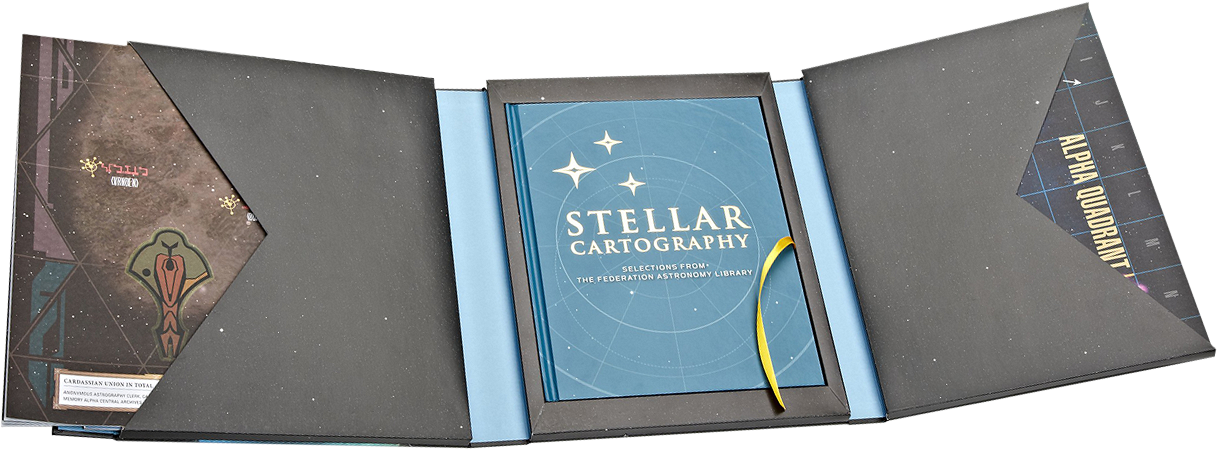Noted Star Trek non-fiction author Larry Nemecek is once again taking on the gauntlet of smoothing over inconsistencies in Star Trek‘s sprawling history with his new book Stellar Cartography. The carefully constructed library of lovingly created Star Trek maps went on sale last month, and we decided to catch up with Larry to discuss the project. We also touched on his seminal work, the TNG Companion as well as the current resurgence of Trek non-fiction.

Notes From Nemecek: Larry Talks Trek Non-Fiction
Interviewed by Adam Walker for TrekCore.com
![]()
TREKCORE: Tell us about the genesis of Stellar Cartography. What was the timeline like, and how did the project come to you?
Larry Nemecek: Well, on one hand, it really started about a year ago. John Van Citters at CBS Consumer Projects and publisher becker&mayer! were talking about doing some projects, and they had this idea and they came to me about it.
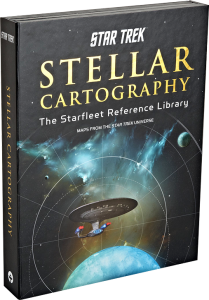
The concept came from CBS about it being alien maps and historical maps — and I basically wrote the book according to the concept they had, which would be a guide for the maps. Our premise was that these were the top ten most requested maps by the public from the repository of Memory Alpha.
But it’s stuff I’ve done for twenty years — something I’ve been doing on my own going all the way back to the 1970’s as a kid, when we thought there wasn’t going to be any more Star Trek.
There were a few of us who wrote back and forth, mostly through the tech-based fanzines; but the main correspondence for me was when I wrote a letter to the Medical Reference Manual that ended up in the lap of Geoffrey Mandel, saying, “Some of the star choices you made for the different races aren’t very smart!” This was after I had already done my own star charts.
He wrote me back, saying “Thank you — two thousand other people have already written me about this, but you’re the only one not screaming at me!” After this, we struck up a conversation and then he went and updated some of my maps with his graphic system to be included in his Officer’s Manual tech zine. He then was called in to take over Bantam’s Star Trek Maps in 1980, so a lot of the work I had done was moot.
There was some of my stuff in those maps, and I was supposed to get credit, and I got burned by the project publisher. Meanwhile, Geoff was creating stars to fill up the empty spaces. I was pissed about it at first, because he put in things like “THX-1138” and “Disney’s Star” and “Barsoom” and some random things to round out the corners. There was a “Nemecek” star which all of my friends just teased me about, but I got over it: that’s where MyStar Media came from, my little brand.
So, okay, fine, I got burned, I thought; I’ll go back and get a life and get on with things. Then The Next Generation came out and we weren’t gap-filling in a vacuum anymore. Mike Okuda, Rick Sternbach, and the rest of the whole show were cranking out more canon than you could keep up with — and then third season, Mike came up with the quadrant system for “The Price,” and after that, we had a real gridwork to gradually fill in.
Then we had all of the good reference books like the TNG Technical Manual, the DS9 Technical Manual, and the series Companions, but they were all “gathered-material” reference books, rather than the “gap-filler” books we used to see. Then when Enterprise was a year in, they came back and Geoff came back and did his Star Trek: Star Charts book that built on what fans had done, and he filled in what they were doing with the show.
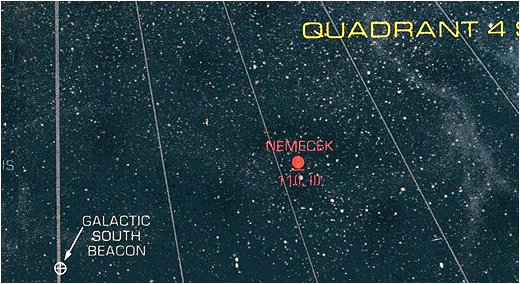
TREKCORE: Didn’t you do the introduction to the chapters on that book?
Larry Nemecek: Yeah, it was kind of funny. Here’s Geoff and I working on our own maps in the 1970’s, then he got called in to do the maps in the 80’s… then in 2002, it was like we were destined to keep crossing paths!
I wrote the chapter intros for Star Charts, but also I kind of gave him all the stuff we had left over – many of the different planet colors, star names for planets we had heard of on the shows, orbital numbers, all that kind of stuff. That was a lot of fun, and I kind of looked over a lot of it.
TREKCORE: One of the biggest concerns people have expressed about the book is that in compared to your previous works – like the TNG Companion – this release is so short in length. Did you have a set number of pages that you were told to fill, or did you just come to a natural conclusion?
Larry Nemecek: It was a hoot — first everybody said, “Hooray, it’s your new book!” And then people get it and go, “Well this is barely a book, it’s all maps!” Well, it’s really both. The maps are the sexy part, but there’s an awful lot of stuff crammed into the book, especially on the Dominion War.
While Pocket Books had gotten to the point where everything was tied into the same format, becker&mayer! has been great about trying to find outside-the-box ideas. They did some big Star Wars presentation books, and they did David A. Goodman’s Federation… and it costs a lot of money to have the maps printed up separately and included in the pouch in this package.
It was planned as a substantial package: ten maps, four written pages for each map – each with a certain word count – and then printed in hardback. That being said, our deadlines were all like last spring. It had to be completed and printed for the 2013 holiday season, but we got started in 2012 since it was going to take six months to have the whole thing printed up in China. Anytime you work on a licensed book, it’s just par for the course; we were only supposed to have three months to do the first edition of the TNG Companion, but it took three months longer than we planned due to issues with the photography.
So I did what I was tasked to do to meet the concept, but some of the chapters had required much more work than others — and then in the crunch, Paula Block helped out on deadline and cut down some of the longer text during editing. I think becker&mayer! thought it was going to be a simpler project than it wound up being!
TREKCORE: That brings me to the next topic. The older Trek non-fiction work – the Star Trek Encyclopedia, Geoff Mandel’s Star Charts, etc. – they were all being put together while the shows were still on the air, so the canon wasn’t complete. Since they came out, we’ve had the explosion of massive fan archives like Memory Alpha which hold every bit of information you could ever ask for. How do you strike the balance between originally-authored content and established work produced by the fans?
Larry Nemecek: That’s really what I was all about — here’s the thing; my first attraction to fandom was gap-filling. I mean, I sat down when I got the original Tech Manual and I was mad, because all those pages intimated in the section contents aren’t really there — they’re just in the table of contents to make it seem like a much huger book… so I sat down and started making all the pages that I wanted!
When The Next Generation came out, everything went from gap-filling to keeping up with the canon. Then we had TWO shows on at a time, then Voyager went into the Delta Quadrant, and it was a scramble! By that time, though, I was professional and had run the Communicator and I had done my Companion, I did the Fact Files, so we had to be like “kings of canon. “

Most of the time, if you take a step back, there is usually a good way to resolve inconsistencies. That’s what I’ve always tried to do; for anything I would do originally, I would consult as much as I could, even in the pre-internet days. So that was all in my bailiwick, but it had just been put on the shelf while we HAD. TO. KEEP. TO. CANON. for years. Actually — halfway through this — John Van Citters had to look at me and say, “Larry, it’s okay! You can unclench! It’s okay to go back and come up with some non-canon things!”
TREKCORE: Did you work in concert with the artists? Did you see the maps first?
Larry Nemecek: Well, I never got to meet the new artists directly, Alie and Ian. They were kind of using the Star Trek Online maps first before we had them pull back — the book is set in 2385, and STO is several decades in the future. We did do the Hobus Supernova from the 2009 film, though, since that was in the “prime” universe.
I loved to see the canon that Alex Kurtzman and Bob Orci laid down in the Countdown comics; it went from being a plain supernova — which made no sense — to a subspace shockwave supernova effect, which thankfully helped smooth out some of the science. And now STO is even doing a plotline where it may have been an unnatural event, some kind of sabotage or something — which makes it even better.
So anyhow, they had already chosen a position for the Hobus star, and it made sense to me so I took STO’s location for Hobus. We decided that the book was set about six months before Hobus went supernova, so we go and give you the Romulus you’d want to know; in fact, the Romulan map is set two years into TNG.
But we started off with the format and some basic labels, then the artists did a pass; we gave notes, then off we went – two more cycles of drafts, all through UPS and email.
TREKCORE: The paper maps themselves are beautiful pieces of artwork — what have you done with yours? Are they up on your walls?
Larry Nemecek: Oh, I only just got my copy! But they’re beautiful; I want to put one up, either the Dominion War one or the ‘kitchen sink’ National Geographic map, the last one. I’m glad Geoff got to do that one; the one complaint people had about the 2002 book was that it was all tiny little pages! So hopefully this will satisfy all those people.
TREKCORE: Then is that one your favorite of the maps?
Larry Nemecek: Well, the Dominon War map is the one I’m most proud of because that one had nothing established, and it had the most problems to fix. Everyone liked those great battle maps they showed on Deep Space Nine; I knew that someday I was going to grab those and put them out — but they make no sense. The guys who made them at the time – Doug Drexler, Mike Okuda, etc. — were just trying to get the things to look good. And Geoff just kind of skipped over it and simply used those maps in his book, which didn’t help anything! [laughs]
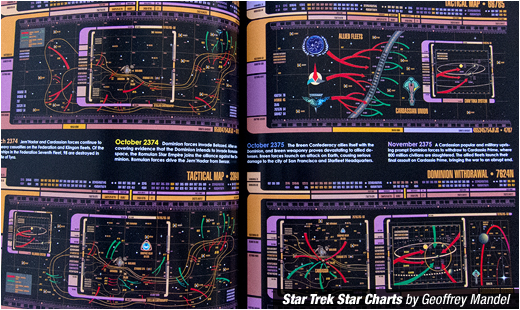
They’re pretty, and they look great, but there are stars on there nowhere near the battle lines by Cardassia or Bajor. So that was the one caveat I came up with to explain them, but make them fit: that they weren’t “to scale” maps – the stars shown were to be like the origin source of each fleet movement. That way, we weren’t ignoring them, and we could sketch out the whole war with every little iota of information along with a ton of information — including where the thing with the Valiant happened, Damar’s resistance bases, and so on. The biggest piece of it all was trying to figure out why were the homeworlds of the Federation always being threatened if the war was happening all the way over by Bajor and Cardassia?
I used two models to address that, based on World War II in the North Atlantic: we imagined that if “Europe” was the Federation, and Cardassia and Bajor were “North America”, then the majority of the Dominion War happened in “the Caribbean.” We figured the Klingons were kind of like the southern flank, like “North Africa,” and then most of the activity was happening in the center of all that, if that makes any sense.
But that first battle — the one we never saw but only heard about the devastation — was the battle of Tyra. There was never really a location given, so what I basically did was made Tyra up around “Iceland.” So if you go up through the Ferengi and the Tzenkethi areas, we put Tyra up there. When that was such a smash-out, it explains why the “northern” Federation worlds were so threatened, and why Benzar was occupied – though the Romulans later liberated Benzar when they came out of their territory.
And then, to explain on this grid how the main “southern” UFP worlds were so threatened when the furthest Dominion advance seemed to hit Betazed and then bog down, I turned to a Persian Gulf War metaphor: the “Baghdad Alley.”
In that short 1991 war, the Iraqis put all their forces into a big border defense, but once the Allies simply pivoted around their end following a bombing campaign, there was a clear and undefended alley right into the capital — had the Allies chosen to go there.
I conceived of that model as the explanation for the “homeworlds threatened” situation, which also had the benefit of lending weight to all the drama around Chin’toka, Betazed, the Argolis Cluster, etc. — that last defense against a great open and undefended expanse. Thankfully, the Dominion never got to break through that “wall” for some open-field running right to Earth, Vulcan, and Andoria.
TREKCORE: A very slight detour now to your TNG Companion, which remains a fan-favorite today. Was there ever a plan to issue the Companion in a color-print format?
Larry Nemecek: Yes, but then the world started to shut down! When they did the Chronology in color and the Encyclopedia in color, the next book was going to be a reprint of the TNG Companion in color.
But somewhere along the way, the sales numbers started going down, and the TV ratings were dropping, so they got cold feet. They had Gar and Judy Reeves-Stevens do that hardcover coffee table book – The Continuing Mission – but after that, they never went back to it. Again, those books in the 90’s were all about having something that made sense to the publishers.

They took a lot of overhead at Pocket Books in New York; they were all budgeted when things were pre-digital. When we did the last update to the Companion – the black one – they asked me if I remembered what font and point size was used on the previous ones, because they were going to have to match the new digital pages to all the old camera-shot pages from the 90’s! Everything had changed in those eight years.
TREKCORE: It certainly seems – and I say this cautiously – that there’s been a bit of a resurgence into Trek non-fiction publishing.
Larry Nemecek: Oh, I have been on this bandwagon for a couple of years. Paula Block and Terry Erdmann’s books are massive and wonderful, but they’re fairly straightforward as production history – what I mean by that is that a publisher wouldn’t feel like they would have to take a big gamble to do them.
David’s book and my book didn’t have as much prep time as we would have loved; nobody thinks more than a year ahead of time unless you’re really invested and you go out and have it done already before you try to sell it. But yeah, we are in a boom — but it will only get “boomier” if everybody goes out and buys! I hate to sound like a car salesman, but people have to vote with their pocketbook and buy the non-fiction and reference and canon gap-filling books. Buy all you can, that’s what sends the message to the publishers.
TREKCORE: Do you think there are still fresh ideas out there, or has everything been done already?
Larry Nemecek: Well, I didn’t think up this concept; I’ll give all the credit to CBS and becker&mayer! who came to me with the idea. The only way it could have been cooler is if we had some kind of 3D holographic thing!
I think there are plenty more ideas down this path to do. We need to do a full atlas of star systems; there are things even in these maps that we could go back and do. We could chart the voyages of the ships, where the different starships actually went; we could do more historical stuff from the other species’ points of view — Klingon or Romulan or Vulcan stuff. Hopefully, we can still do a few more. There are plans do some more things, but it really depends on the fan reaction.
TREKCORE: Well, I’ll ask you to put your car salesman hat on one more time — to those fans who are on the fence, and who may already own Star Charts and all the other non-fiction books, why should this go on their wish list?
Larry Nemecek: Oh, well, if for nothing else, if you’re a Klingon or Vulcan fan or whatever, the Klingon map is all in Klingonese; frame it and hang it in your Klingon room. Put the Vulcan system map in your Vulcan corner. I think gamers can use the big maps for great ship-to-ship gaming — take the Alpha and Beta Quadrant maps and put them under plastic and game on top of them.
If you’re an in-universe Trek history fan, then there are a lot of dots connected in the book — and followed through in the maps — that maybe you haven’t thought about. And if nothing else, the Dominion War finally makes sense!
There’s just a ton of stuff in this that has never been put out before, AND it was priced at $47.99 — what more of a sign do you need to go get it?
![]()
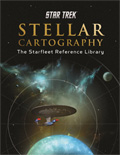 |
Order Star Trek Stellar Cartography |
|
|
|
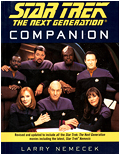 |
Order Star Trek: TNG Companion |

